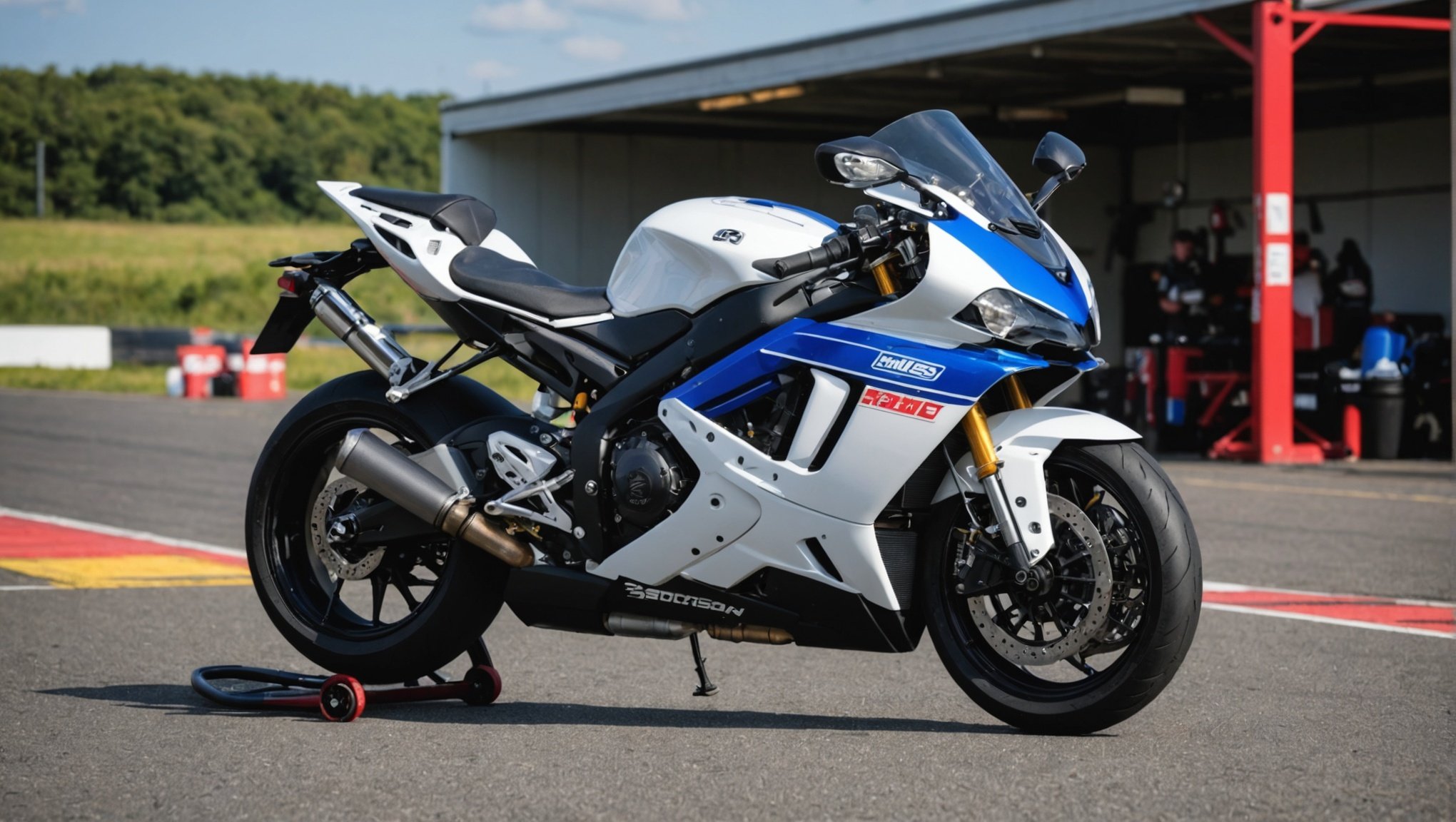Suspension setup can make or break your track day experience. Whether you're navigating tight corners or blazing down straightaways, the right adjustments can enhance handling and comfort, boosting both performance and enjoyment. This guide offers insights tailored for UK riders, covering the nuances of suspension components, settings, and best practices. Elevate your skills and confidence on the track with our expert advice, ensuring your sport bike is perfectly tuned for optimum performance. Get ready to transform your ride!
Understanding Suspension Basics
Before diving into the intricacies of sport bike performance, it's crucial to grasp the Suspension Fundamentals. At its core, a bike's suspension is composed of several key Suspension Components: forks, shocks, springs, and dampers. Each plays a vital role in ensuring a smooth and responsive ride.
Also to discover : Unlocking Speed: Mastering Aerodynamic Enhancements for Your Sport Bike in UK High-Speed Racing
The forks are located at the front and are pivotal in steering and absorbing bumps. Shocks, usually found at the rear, help maintain stability and comfort by absorbing larger impacts. Springs support the bike's weight, while dampers control the speed of the suspension's movement, preventing excessive bouncing.
A well-tuned suspension setup is paramount for sport bike performance. It directly influences how the bike handles, particularly in high-speed scenarios. Proper suspension setup enhances cornering ability, improves traction, and provides the rider with better feedback from the road.
Also to see : Rev Up Your UK Sport Bike: Will a Clutch Upgrade Enhance Your Lap Times?
Moreover, the suspension is integral to safety on the track. It ensures that the tyres maintain optimal contact with the surface, reducing the risk of skidding or losing control. Understanding and adjusting these components can significantly enhance both handling and safety, allowing riders to push their limits with confidence.
Track Day Suspension Setup Essentials
When preparing a sport bike for a Track Day Setup, understanding the nuances of Suspension Adjustments is essential. Key factors to consider include the bike model, rider weight, and riding style, which all influence the optimal setup.
Key Factors for Track Day Setup
- Bike Model: Different models have unique suspension characteristics. Manufacturers often provide recommended baseline settings, which serve as an excellent starting point for adjustments.
- Rider Weight: The suspension must be tailored to accommodate the rider's weight. Heavier riders may require stiffer springs or increased preload to maintain balance and control.
- Riding Style: Aggressive riders may benefit from firmer suspension settings for better cornering and stability, while a more relaxed style might prefer softer settings for comfort.
Recommended Baseline Settings
While specific settings vary, common adjustments include:
- Preload: Adjust to ensure the bike maintains the correct ride height.
- Compression and Rebound Damping: Fine-tune to control how quickly the suspension compresses and rebounds, affecting grip and handling.
By considering these factors and making precise Suspension Adjustments, riders can enhance their bike's performance on the track, ensuring a safer and more exhilarating experience.
Adjusting Suspension for Different Track Conditions
Understanding how track conditions affect your sport bike's performance is crucial for optimal suspension tuning. Weather and surface conditions can significantly influence suspension settings, requiring specific adjustments for varying scenarios.
Impact of Weather and Surface Conditions
Weather plays a pivotal role in determining the appropriate suspension setup. For instance, a wet track demands a softer suspension to enhance grip and maintain stability. This adjustment allows tyres to better conform to the slippery surface, reducing the risk of skidding. Conversely, on a dry track, a firmer setup is beneficial to maximise traction and cornering precision.
Adjustments for Wet vs. Dry Track Conditions
- Wet Conditions: Opt for softer springs and reduced damping. This configuration improves tyre contact with the track, providing better control in slippery conditions.
- Dry Conditions: Increase spring stiffness and damping. This setup enhances stability and responsiveness, allowing for sharper handling and improved feedback from the track.
Strategies for Optimizing Suspension Based on Track Layout
Different track layouts demand tailored suspension strategies. Tight, twisty circuits might require a softer setup for agility, while fast, sweeping tracks benefit from a firmer configuration to maintain high-speed stability. By fine-tuning your bike's suspension to match track conditions, you can achieve superior performance and safety.
Tools and Equipment for Suspension Setup
To achieve optimal suspension tuning, having the right suspension tools and maintenance equipment is essential. These tools not only facilitate precise adjustments but also ensure safety and efficiency during setup.
Essential Tools for Adjusting Suspension
- Torque Wrench: Critical for ensuring bolts are tightened to the manufacturer's specifications, preventing over-tightening or loosening during rides.
- Suspension Sag Scale: Measures the sag of the suspension, helping to adjust preload accurately for different rider weights.
- Shock Spanner Wrench: Used to adjust the preload on rear shocks, crucial for tailoring the bike's balance and ride height.
Recommended Maintenance Equipment for Track Day Prep
- Fork Oil Level Gauge: Ensures the correct amount of oil in the forks, which is vital for consistent damping performance.
- Air Pressure Gauge: Regularly checking tyre pressure is crucial for maintaining grip and handling, especially on track days.
Tips for Using Tools Effectively and Safely
- Always refer to the bike's manual for specific torque settings and adjustment procedures.
- Use tools on a stable surface to prevent accidents.
- Regularly inspect and maintain your tools to ensure their longevity and reliability.
Equipped with the right tools, riders can confidently adjust and maintain their bike's suspension, enhancing performance and safety on the track.
Specific Recommendations for Popular Sport Bike Models
When it comes to optimising sport bike models, tailoring the suspension to each specific bike is crucial. Different models have unique characteristics that require distinct suspension tips to achieve peak performance.
Detailed Setup Recommendations for Top Sport Bike Models
For the Yamaha YZF-R1, a common recommendation is to start with a slightly firmer spring setup. This adjustment enhances stability during high-speed cornering, a hallmark of this model. The Kawasaki Ninja ZX-10R benefits from a balanced approach, focusing on equal preload distribution to maintain its agility and responsiveness.
Common Suspension Issues Faced by Riders on Specific Models
Riders of the Suzuki GSX-R600 often report excessive front-end dive under braking. Addressing this involves increasing the compression damping to provide better support. Meanwhile, Honda CBR1000RR riders frequently face rear-end squatting. Adjusting the rear preload can counteract this, improving overall handling.
Case Studies of Successful Setup Adjustments
Consider a case where a Ducati Panigale V4 owner experienced improved lap times by fine-tuning the rebound damping. This adjustment enhanced tyre contact and stability, particularly on tighter circuits. By understanding these suspension tips and making informed adjustments, riders can significantly enhance the performance of their sport bike models.
Suspension Maintenance Practices
Ensuring your sport bike's suspension maintenance is up to par is vital for performance longevity. Regular checks are essential to keep the suspension in optimal condition, preventing potential issues on the track or road.
Regular Maintenance Checks
Conducting routine inspections helps identify signs of wear and tear before they become significant problems. Look for oil leaks around the forks or shocks, as these can indicate seal failure. Also, check for unusual noises or changes in handling, which might suggest component wear.
Signs of Wear and Tear
Be vigilant for symptoms like uneven tyre wear or sagging suspension, which can affect performance and safety. If the bike feels unstable or bouncy, it might be time to examine the springs and dampers. Addressing these issues promptly can prevent further damage and ensure a smoother ride.
Best Practices for Suspension Care
- Clean Components: Regularly clean the suspension parts to remove dirt and grime that can cause wear.
- Lubricate Moving Parts: Keep all moving parts well-lubricated to reduce friction and wear.
- Follow Manufacturer Guidelines: Always adhere to the manufacturer's maintenance schedule and specifications for optimal performance.
By following these practices, riders can maintain their bike's suspension effectively, ensuring it remains in peak condition for longer.
Understanding Track Regulations and Compliance
Navigating track regulations is essential for any sport bike enthusiast planning to participate in a track day event. In the UK, these regulations are designed to ensure both safety and optimal performance. Each track may have specific compliance standards that participants must adhere to, including noise limits and safety gear requirements.
To start, understanding the noise regulations is crucial. Most UK tracks enforce a maximum noise level, often measured in decibels, to minimize disturbance to surrounding areas. Ensuring your bike meets these limits is vital, as exceeding them can result in disqualification from the event.
Moreover, compliance extends to safety gear. Riders must wear approved helmets, gloves, and leathers. These items are not only mandatory but also critical for personal safety during high-speed activities.
Preparing your bike for regulatory checks involves several steps. First, ensure your bike's exhaust system is within the permitted noise levels. Regular maintenance checks, such as examining brakes and tyres, are also necessary to comply with safety standards. Additionally, having documentation of any modifications can expedite the inspection process. By adhering to these track regulations, riders can focus on enjoying their track day experience safely and confidently.
User Experiences and Testimonials
Rider experiences provide invaluable insights into the practical aspects of suspension setups. Many seasoned riders share that understanding the nuances of their bike's suspension can significantly enhance performance on track days. For instance, adjusting the damping settings based on personal feedback can lead to improved handling and stability.
Testimonials from the track often highlight common pitfalls. A frequent issue is neglecting to adjust the preload for different track conditions, leading to suboptimal ride heights and compromised control. Riders have learned that even small tweaks can make a substantial difference, particularly in cornering precision and traction.
User feedback is crucial for informing suspension adjustments. Experienced riders often recommend keeping a detailed record of settings used during different track conditions. This practice allows for a more tailored approach to tuning and helps identify what works best for individual riding styles. By sharing their experiences, riders contribute to a broader understanding of effective suspension tuning, helping others avoid common mistakes and optimise their setups for better performance.
Visual Aids and Resources for Suspension Setup
Understanding suspension setup can be daunting, but visual aids like diagrams and charts simplify complex concepts. These tools illustrate how each component interacts, aiding in grasping the intricate dynamics of suspension systems. For example, a diagram showing how dampers and springs work together can clarify their roles in maintaining bike stability.
Online resources are invaluable for further learning. Websites dedicated to sport bike maintenance often provide detailed guides and articles. These resources offer insights into suspension adjustments tailored to specific models and track conditions. Additionally, forums and community platforms allow riders to share experiences and tips, enhancing collective knowledge.
Video tutorials are particularly useful for those seeking hands-on guidance. Platforms like YouTube host a plethora of instructional videos, covering everything from basic setup to advanced tuning techniques. Watching experts adjust suspension components in real-time offers a practical perspective, bridging the gap between theory and practice.
Incorporating these visual aids and resources into your learning process can significantly enhance your understanding of suspension setup. They provide a comprehensive approach, combining visual learning with practical advice, ensuring you're well-equipped to optimise your sport bike's performance.













